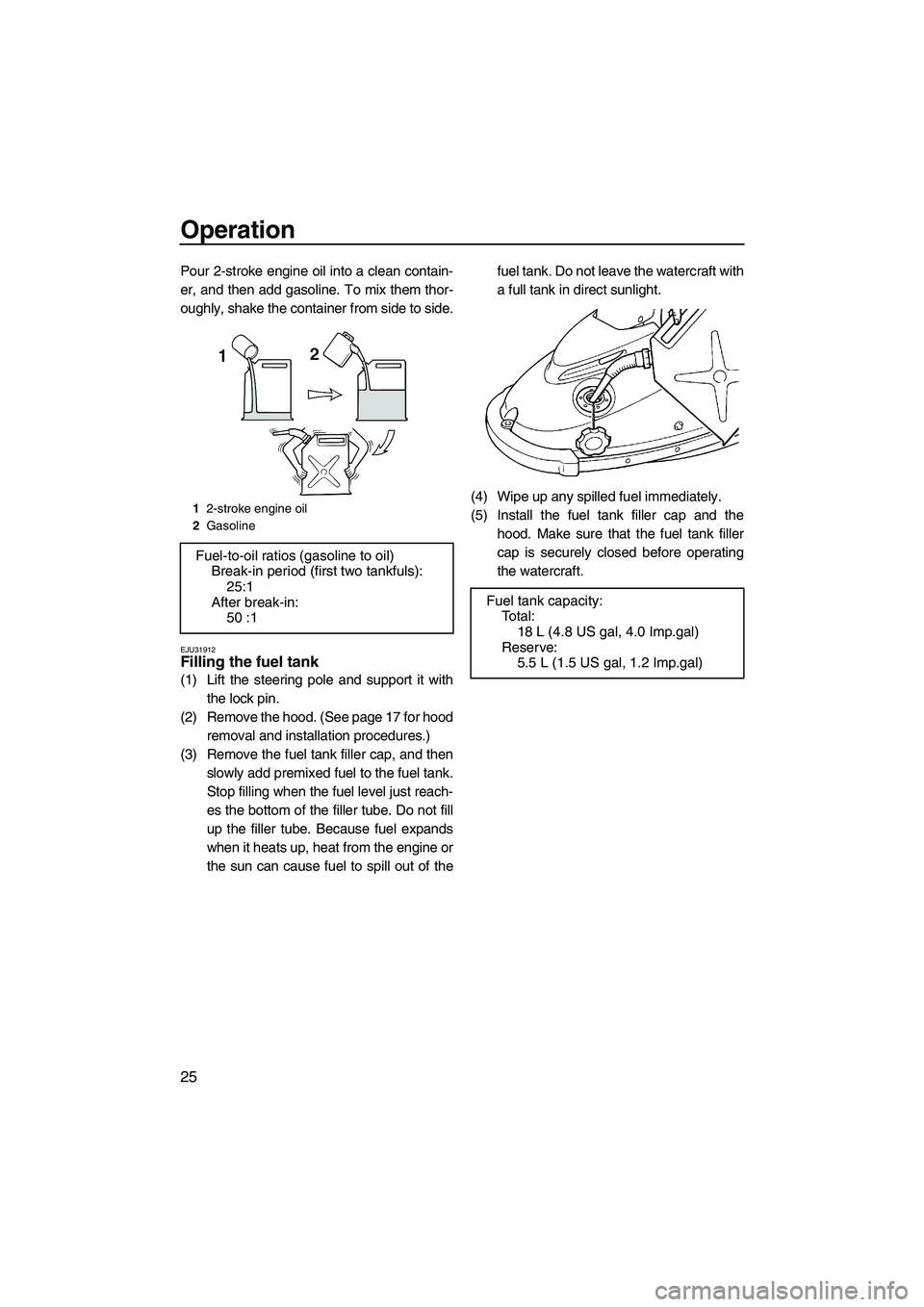Page 21 of 76

Safety information
14
EJU30991
Enjoy your watercraft
responsibly
You share the areas you enjoy when riding
your watercraft with others and with nature.
So your enjoyment includes a responsibility to
treat these other people, and the lands, wa-
ters, and wildlife with respect and courtesy.
Whenever and wherever you ride, think of
yourself as the guest of those around you. Re-
member, for example, that the sound of your
watercraft may be music to you, but it could be
just noise to others. And the exciting splash of
your wake can make waves others won’t en-
joy.
Avoid riding close to shoreline homes and wa-
terfowl nesting areas or other wildlife areas,
and keep a respectful distance from fisher-
men, other boats, swimmers, and populated
beaches. When travel in areas like these is
unavoidable, ride slowly and obey all laws.
Proper maintenance is necessary to ensure
that the exhaust emission and sound levels of
your watercraft will continue to be within regu-
lated limits. You have the responsibility to
make sure that the recommended mainte-
nance in this owner’s/operator’s manual is
carried out.
Remember, pollution can be harmful to the
environment. Do not refuel or add oil where a
spill could cause damage to nature. Remove
your watercraft from the water and move it
away from the shoreline before refueling. Dis-
pose of water and any fuel and oil residue in
the engine compartment according to local
regulations. And keep your surroundings
pleasant for the people and wildlife that share
the waterways: don’t litter.
When you ride responsibly, with respect and
courtesy for others, you help ensure that ourwaterways stay open for the enjoyment of a
variety of recreational opportunities.
UF2F71E0.book Page 14 Thursday, April 10, 2008 11:47 AM
Page 32 of 76

Operation
25
Pour 2-stroke engine oil into a clean contain-
er, and then add gasoline. To mix them thor-
oughly, shake the container from side to side.
EJU31912Filling the fuel tank
(1) Lift the steering pole and support it with
the lock pin.
(2) Remove the hood. (See page 17 for hood
removal and installation procedures.)
(3) Remove the fuel tank filler cap, and then
slowly add premixed fuel to the fuel tank.
Stop filling when the fuel level just reach-
es the bottom of the filler tube. Do not fill
up the filler tube. Because fuel expands
when it heats up, heat from the engine or
the sun can cause fuel to spill out of thefuel tank. Do not leave the watercraft with
a full tank in direct sunlight.
(4) Wipe up any spilled fuel immediately.
(5) Install the fuel tank filler cap and the
hood. Make sure that the fuel tank filler
cap is securely closed before operating
the watercraft.
12-stroke engine oil
2Gasoline
Fuel-to-oil ratios (gasoline to oil)
Break-in period (first two tankfuls):
25:1
After break-in:
50 :1
Fuel tank capacity:
To t a l :
18 L (4.8 US gal, 4.0 Imp.gal)
Reserve:
5.5 L (1.5 US gal, 1.2 Imp.gal)
UF2F71E0.book Page 25 Thursday, April 10, 2008 11:47 AM
Page 64 of 76

Maintenance and care
57
nents. Have a Yamaha dealer lubricate the
handlebar pivot shaft.
�Intermediate housing
Fill the intermediate housing with water-re-
sistant grease through the grease nipple
using a grease gun.
EJU34440Adjusting the choke cable
Check that the choke cable is properly adjust-
ed.
(1) Pull the choke knob out until it stops, and
then release the knob. The knob should
not move.(2) If the choke knob moves back on its own,
tighten the choke knob adjusting nut
slightly. If the knob is difficult to move,
loosen the adjusting nut slightly.
EJU34452Checking the battery
Check the level of the battery electrolyte and
make sure that the negative (–) and positive
(+) battery leads are tightened securely.
WARNING
EWJ00791
Battery electrolyte is poisonous and dan-
gerous, causing severe burns, etc. Elec-
trolyte contains sulfuric acid. Avoid
contact with skin, eyes, or clothing.
Antidotes
External: Flush with water.
Internal: Drink large quantities of water or
milk. Follow with milk of magnesia, beaten
egg, or vegetable oil. Call a physician im-
mediately.
Eyes: Flush with water for 15 minutes and
get prompt medical attention.
Batteries produce explosive gases. Keep
sparks, flames, cigarettes, etc., well away.
If using or charging the battery in an en-
closed space, make sure that it is well ven-
tilated. Always shield your eyes when
working near batteries.
Keep out of the reach of children.
Grease quantity:
Initial 10 hours or 1 month:
20.0–22.0 cm³ (0.68–0.74 US oz,
0.71–0.78 Imp.oz)
Every 100 hours or 12 months:
3.0–5.0 cm³ (0.10–0.17 US oz,
0.11–0.18 Imp.oz)
1Choke knob adjusting nut
UF2F71E0.book Page 57 Thursday, April 10, 2008 11:47 AM